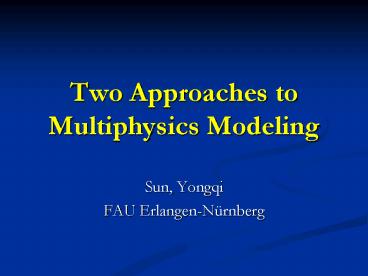Two Approaches to Multiphysics Modeling PowerPoint PPT Presentation
1 / 18
Title: Two Approaches to Multiphysics Modeling
1
Two Approaches toMultiphysics Modeling
- Sun, Yongqi
- FAU Erlangen-Nürnberg
2
Content
- Introduction
- Patch Simulation
- Mesoscale Simulation
3
Introduction
- 1.1 Objects
- Multiple simultaneous physical phenomena
- Multiple physical models - PDEs
4
Introduction
- 1.2 Application Examples
- Space weather plasma kinetics magneto
hydrodynamics - Fluid-structure interaction
- fluid dynamics structural mechanics
- Materials fracture molecular dynamics solid
mechanics - Distributed network performance
- discrete event dynamics stochastic
fluid models - Nanodevice electronics
- quantum kinetic theory quantum
hydrodynamics
5
Introduction
- 1.3 Scales Time and Space
- Macro continuum reaction and transport (PDEs)
- e. g. mass-action chemical kinetics,
- hydrodynamics (Navier-Stokes Eq.)
- Micro physically motivated discrete models
- e. g. molecular dynamics
- Boltzmann kinetic theory
- crack propagation
6
Introduction
- 1.4 Approaches
- Patch dynamics
- when only microscopic model is available
- to predict macroscopic space-time scales
behaviour - Mesoscale model
- bridge of macro- and microscale methods
- hybrid models for specific kinds of
problems
7
Patch Simulation
- 2.1 Idea
- Predict system-level behaviour (macroscale) from
locally averaged properties (microscale) - Macroscopic equations are unavailable (highly
non-linear, singular) or equations for the higher
moments on microscale are unavailable
8
Patch Simulation
- 2.2 Application Examples
- Molecular dynamics
- Lattice-Boltzmann particles methods
- Reaction-diffusion equations
- Epidemiology
9
Patch Simulation
- 2.3 Algorithms Finite difference methods
- Microscopic initial conditions agree with the
macroscale averages at the grid points lifting - Interpolate the macroscale averages macroscopic
solution and microscopic boundary conditions - Solution in each patch by microscopic model
- Integration of the microscopic model changes in
macroscale averages and time derivatives
restriction - Advance macroscopic variables in time
10
Patch Simulation
- One-dimentional problem
11
Patch Simulation
- Space-time plot for the patches
12
Patch Simulation
- 2.4 Overview
- Microscale structure solution varies rapidly
- Macroscale structure smooth locally averaged
- Patch boundary conditions communicate between
patches, obtained from macroscale reconstructed
solution - Buffer region microscale solutions statistical
properties - Macroscale reconstructed solution local
interpolation of macroscopic field variables
13
Patch Simulation
- 2.5 Accuracy Assumption
- Macroscale is separated from microscale
- i. e. ?x ltlt?X, ?t ltlt?T
- Macroscale variables are sufficient to determine
the systems dynamics and define the microscopic
i. c. - Microscale model is well defined
- Macroscale model is statistically stable to small
perturbations in the microscale - The reference grid accurately resolves the
macroscale solution
14
Patch Simulation
- 2.6 Crucial Steps
- Lifting the microscale i. c. from macroscopic
(balance between microscopic forces)
defect-correction algorithm (maximum entropy
approach) - Bridging the spatial gaps (microscale b. c. must
agree with macroscale) polynomial interpolation,
global conservation - Bridging the temporal gaps (average time
derivatives and the time derivatives of the
spatial moments) microscale integration(e. g.
Runge-Kutta)
15
Mesoscale Simulation
- 3.1 Problems with Macro- and Microscale
Simulation - Microscopic methods are computationally expensive
- e. g. Molecular Dynamics 100 nanometers,
several tens of nanoseconds - Macroscopic models usually fail with microscale
- e. g. continuum hypothesis break down for
approximately 10 molecules - The coupling of two methods has problems
- e. g. noise at the interface, conservation
of mass or momentum
16
Mesoscale Simulation
- 3.2 Example of mesoscale method
- Dissipative Particle Dynamics model
- Area complex liquids and dense suspensions
- Content Model of polymer chains in dilute
solutions different forces on polymer- and
solvent particles - Different time scale time-staggered integrating
scheme with two different time steps smaller
for polymer particles and larger for solvent
particles
17
References
- J. M. Hyman, Patch Dynamics For Multiscale
Problems, Computing in Science Engineering,
May/June 2005. - V. Symeonidis et al., A Seamless Approach To
Multiscale Complex Fluid Simulation, Computing
in Science Engineering, May/June 2005.
18
- Thanks for your attention!

